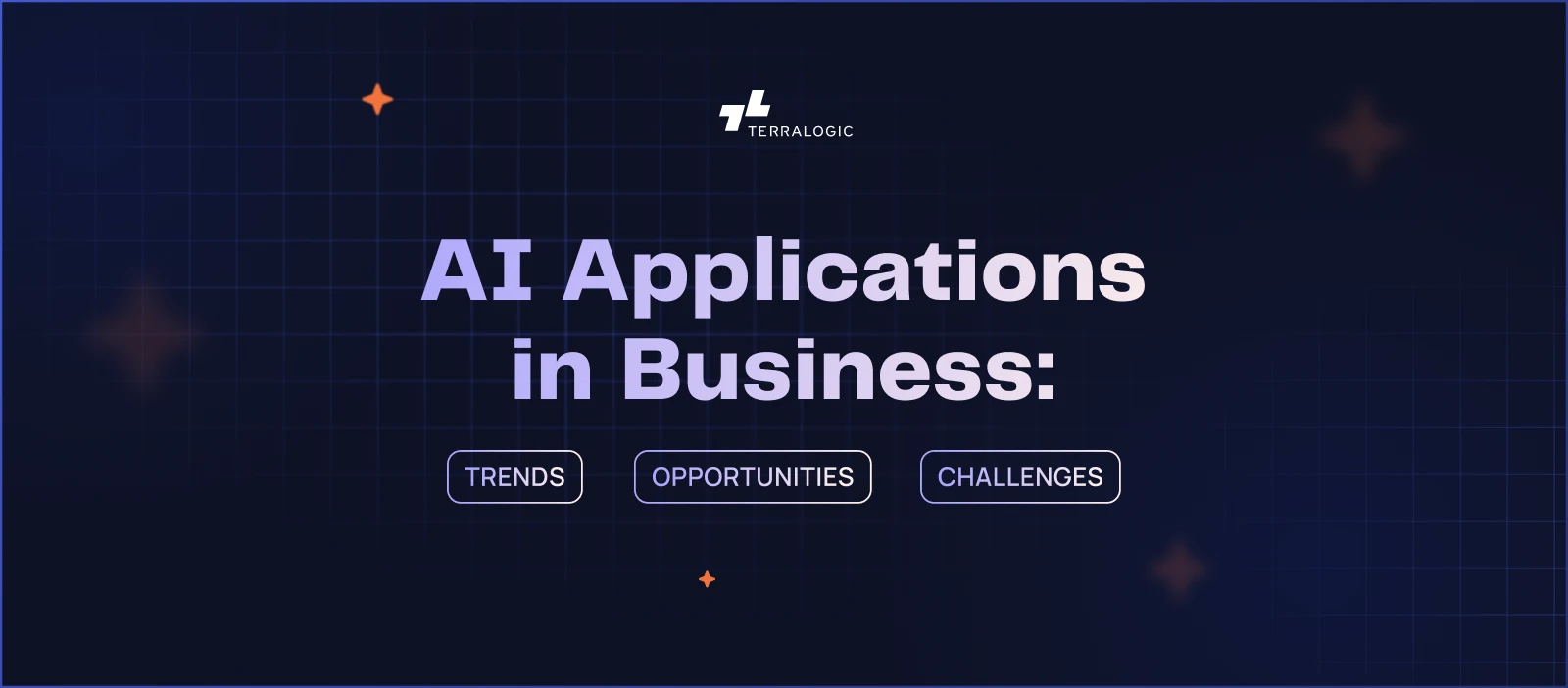AI Applications in Business: Trends, Opportunities, and Challenges for 2026
November 20, 2025

Knowing the difference between implementing AI and implementing AI that actually drives business results is what’s going to separate the winners from the rest.
You might have spent millions on AI initiatives, tools, pilots, and dashboards, but if you can’t clearly show the ROI, you’re not alone. Many businesses have adopted AI, but few have turned it into a measurable impact.
Meanwhile, your competitors with half your budget are using AI to cut customer acquisition costs by 40% and achieve forecasting accuracy that’s transforming how they allocate capital.
The gap isn’t technical. It’s strategic.
We’re at a tipping point. AI in business has shifted from experimental to essential, from nice-to-have to a competitive necessity.
The companies winning with AI aren’t just adopting new technology; they’re rethinking how they create value.
2026 isn’t about whether you’ll use AI. It’s about how strategically you’ll use it before your competitors figure it out first.
Key AI Business Trends in 2026
The AI business trends 2026 aren’t just incremental improvements. They’re paradigm shifts that are rewriting competitive dynamics across industries.
Generative AI Goes Enterprise
Remember when ChatGPT broke the internet? That was just the beginning. This year, enterprise AI applications are moving beyond chatbots into core business functions. Companies are using generative AI to create marketing campaigns, draft legal documents, generate product designs, and even write code at scale.
Here is the catch: businesses are using AI for product innovation. There are Saas Companies that use AI to create personalized onboarding experiences for each customer segment. Their activation rates jumped 35% in two quarters.
AI Agents: Your new digital workforce
AI agents are evolving. They are now autonomous digital workers that can handle complex, multi-step business processes.
Think about your support team spending hours routing tickets, gathering information, and providing status updates. AI agents can now handle all of that, understanding context, making decisions, and escalating only when human judgment is truly needed.
Hyper-Automation Redefines Efficiency
AI-driven automation in 2026 is more than replacing manual tasks. It’s about reimagining entire workflows. The companies leading this shift are seeing operational efficiency gains that fundamentally change their entire unit economics.
For example, A leading logistics company reported a 22% reduction in average delivery times and a 15% decrease in fuel consumption following AI implementation.
Industry-Specific AI Becomes Standard
The latest AI trends in business for 2026 show clear divergence by industry.
- Healthcare is deploying predictive diagnostics to catch diseases months earlier.
- Retail is leveraging AI for hyper-personalization recommendations, which is much better than Amazon’s.
- Finance is implementing fraud detection systems that identify suspicious patterns in milliseconds.
The pattern? Generic AI is being replaced by industry-specific solutions that understand domain nuances and deliver measurable business outcomes.
Opportunities AI Brings to Enterprises
Let’s talk about what actually matters: the opportunities of AI for CEOs and business leaders that translate to competitive advantage and shareholder value.
Cost Reduction That Compounds
What is most missed: AI’s cost savings don’t just add up. They compound over time. When you automate a process, you don’t just save money for one day. You eliminate that cost permanently while often improving quality simultaneously.
A manufacturing company implemented AI-powered quality control that reduced defect rates by 82%. The direct cost savings were significant, but the real impact was in reducing warranty claims. improving customer satisfaction, and enabling them to pursue premium market segments they couldn’t serve before.
Decision-Making That’s Actually Data-Driven
Every executive claims to be data-driven. Most are actually spreadsheet-driven. Benefits of AI-powered applications in enterprises include executing reactive analysis into predictive intelligence.
A retail client used AI to analyze hundreds of variables affecting demand, weather, local events, social media trends, and economic indicators. TMegaRetail achieved an 8.8% on-shelf availability improvement and an $18M+ working capital reduction through AI-enhanced inventory decisions.
That’s not better reporting; that’s better business.
Personalization as Competitive Moat
You might have seen several websites that feel similar. Say no to generic experiences. Customers now expect personalization so sophisticated it feels like mind-reading. AI makes this economically possible at scale.
An e-commerce company implemented AI to create individualized shopping experiences for each visitor. Not just “customers who bought this also bought that,” but dynamic pricing, personalized product bundles, customized content, and tailored promotions based on hundreds of behavioral signals.
Result:
- Conversion rates are 3x the industry average.
- Customer lifetime value increased by 4x.
That’s not incremental improvement; that’s fundamental competitive advantage.
Speed as a strategic weapon
AI opportunities for enterprises increasingly revolve around speed. The ability to iterate faster, respond to market changes quickly, and make decisions with less lag time creates compounding advantages.
A financial services firm implemented AI-powered underwriting that reduced approval times from 5 days to 5 minutes. They didn’t just improve customer experience; they fundamentally changed their competitive position and grabbed market share from slower incumbents.
Challenges Businesses Face with AI Applications
Now, let’s talk about why most AI initiatives still fail, because understanding the challenges of AI adoption in business is crucial for avoiding expensive mistakes.
- The Data Swamp Problem: Everyone talks about being data-rich. Most companies are actually data-poor with lots of stored information. There’s a massive difference. Many of them struggle with fragmented, unstructured data that leads to bad outcomes.
- Scalability Issues: Many AI projects succeed in pilot phases but fail to scale. Reasons include lack of integration, unclear ROI, and insufficient executive support.
- The People Problem Nobody Talks About: Technology is rarely the limiting factor in AI adoption. People are. Most of the employees resist the AI as it changes how they demonstrate value. And the way it is implemented in the daily process creates more friction.
- Security and Compliance Landmines: Enterprise AI applications create new attack surfaces and compliance challenges that most organizations aren’t prepared to handle. AI models can leak sensitive data. Automated decisions can create regulatory liability. Biased algorithms can lead to discrimination lawsuits.
Many companies rush into AI implementation without proper security frameworks, only to face costly breaches or regulatory penalties that wipe out years of efficiency gains.
How Leaders Can Prepare for AI in 2026
Here’s the framework smart business leaders are using to actually succeed with AI:
Start with business outcomes, not technology
- Most companies focus on what they can do with AI, instead of focusing on what problems they can solve.
- Leaders need to define goals like revenue growth, cost reductions, or satisfaction and work towards them.
- This approach ensures every investment in enterprise AI applications drives real value, not just innovation.
Build Trust and transparency
- Even the most advanced AI-powered applications in enterprises fail without user trust.
- Teams need visibility into how AI makes decisions and when human oversight is required.
- Investing in explainable AI, user experience, and change management addresses the major challenges of AI adoption in business.
Build for Scale from Day One
- The latest AI trends in business for 2026 emphasize scalability and seamless integration.
- Design every AI initiative with a clear path from pilot to production.
Partner Strategically
- The right partnerships unlock AI opportunities for enterprises. Collaborate with experts who align technology with business strategy.
Keep Adapting
- The future of AI in business belongs to leaders who continuously learn, evolve, and refine their strategies as AI advances.
Conclusion
The gap between AI hype and AI results has never been wider.
While everyone’s talking about AI, most companies are still struggling to extract real business value from their investments. The challenges of AI adoption in business are real, significant, and often underestimated.
The opportunities of AI for CEOs and business leaders are even more significant. 2026 is the year when AI moves from experimental to operational, from optional to essential. The question isn’t whether AI will transform your industry; it’s whether you’ll lead that transformation or be left scrambling to catch up.
The businesses winning aren’t trying to do everything with AI. They’re being strategic about where AI creates the most value, thoughtful about implementation, and realistic about challenges.
Your competitors are already moving. The technology is ready. The question is, are you?
FAQs
How can AI change your business in 2026?
AI is shifting from experimental tools to strategic growth engines in 2026. Simplifying operations, predicting market trends, personalizing customer experiences, and automating decision-making will be done by AI. Once integrated, AI into core functions will see measurable gains in efficiency, profitability, and speed to market.
How will AI impact business in the next 10 years?
Over the next decade, AI will blend into every part of business, be it strategy, operations, or engaging with customers. It will redefine competitive advantage, decrease delivery cycles, increase adaptability, and make more data-driven decisions.
What are the 5 applications of AI?
Here’s where the real impact happens:
Predictive Intelligence: Spot trends and risks before they appear.
- AI Agents: Digital teammates that run processes, not just tasks.
- Generative AI: Content, code, and design done in minutes, not months.
- Personalization Engines: Every customer gets an experience built for them.
- Fraud & Risk AI: Stopping threats faster than humans can react.
These aren’t “future ideas.” They’re already rewriting how top companies work.
How can AI be used in my business?
AI can be applied to your business to automate repetitive tasks, data-heavy work, or decision-based processes and automate them for better performance. Whether it’s in customer services, predictive sales analytics, dynamic pricing, or supply chain optimization, start with a small, clear target, then scale as models perform. The more data you have, the more accurate future decisions you can make.
What are the challenges of adopting AI in business?
Common challenges include poor data quality, limited scalability, a lack of skilled talent, and resistance from employees. Many companies also overlook governance and security risks. The solution lies in starting with clear business outcomes, building explainable and ethical AI systems, and ensuring cross-functional alignment from leadership to execution.
Keep reading about
LEAVE A COMMENT
We really appreciate your interest in our ideas. Feel free to share anything that comes to your mind.
Our 16 years of achievements includes:
10M+
lines of codes
2400+
projects completed
900+
satisfied clients
16+
countries served




